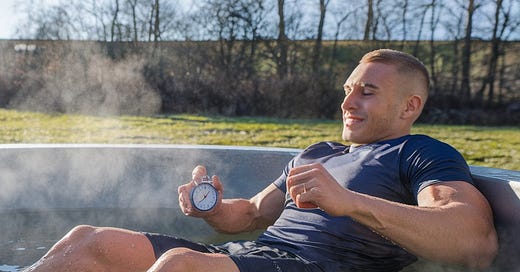The Cold Truth Part 1: The Science Behind Cold-Water Immersion for Exercise Performance
Cold Water Immersion: A Recovery Tool for Everyone?
Cold-water immersion (CWI) isn’t just for pro athletes. It can be a simple, effective way to speed up recovery. The best part? You don’t need to be an elite competitor to reap the benefits. However, it’s important to know when and if this strategy is truly necessary for your routine.
Optimal Water Temperature and Immersion Time
Water Temperature: Aim for water temperatures between 10°C to 15°C (50°F to 59°F). This range is cool enough to ease inflammation and muscle soreness without making the experience too uncomfortable.
Immersion Time: Involves immersing the body or limbs. Keep sessions between 10 to 15 minutes. For lighter workouts, shorter dips of 5-10 minutes work well. More intense training might need the full 15 minutes.
High-Intensity Workouts: HIIT, CrossFit, Circuit Training
High-intensity interval training (HIIT), CrossFit, or circuit workouts can leave you sore and fatigued. Cold-water immersion can help with that.
Reduce Muscle Soreness: CWI can ease the delayed onset muscle soreness (DOMS) that often follows intense sessions.
Best Practice: Use CWI right after your workout. It’ll help your muscles recover faster, keeping you ready for your next session. Make it a routine on your high-intensity training days. Consistency is key.
Strength Training and Muscle Building
If strength and muscle growth are your main goals, CWI can still play a role. But there’s a catch.
Use Sparingly for Muscle Growth: While CWI reduces soreness, it can also reduce muscle inflammation. This inflammation is a crucial part of the muscle-building process. Overuse might interfere with gains.
Minimal Impact on Strength Recovery: Studies show that CWI doesn’t significantly boost strength recovery. It helps with soreness, but not necessarily with muscle function or performance.
Best Practice: Save CWI for particularly tough, heavy lifting days if soreness is severe.
Endurance and Cardio Exercise: Running, Cycling, Swimming
For endurance athletes, CWI can make a big difference.
Maintain Endurance Performance: Runners, cyclists, and swimmers often struggle with muscle fatigue. Cold-water immersion helps manage core temperature and eases muscle tension, making it great for recovery after long sessions.
Best Practice: Use CWI after long runs, cycling events, or tough swim sessions. Ten to fifteen minutes will cool down your muscles and lower perceived exertion. This means you’ll feel fresher for your next workout. If you’re tackling multi-day events, CWI can help keep your muscles in top shape.
Adjusting for Environmental Conditions
Exercising in hot conditions? CWI can be your cool-down lifesaver.
Hot Weather Training: When you’re training in the heat, CWI cools you down fast. It helps prevent overheating and speeds up post-workout recovery. Perfect for outdoor summer workouts or indoor training spaces without proper cooling.
Best Practice: On hot days, consider using CWI during training breaks. A quick 5-minute dip in cooler water can keep you comfortable and improve performance.
Practical Tips for Safe Cold-Water Immersion
Avoid Extended Immersion: Don’t go beyond 15 minutes. Staying in cold water too long can be risky, leading to issues like hypothermia. Stick to recommended times.
Ease Into It: If you’re new to CWI, start with slightly warmer water (around 15°C) and shorter sessions (5-8 minutes). Let your body adjust gradually.
Warm Up Slowly: After CWI, warm up your body slowly. Use a towel, dress warmly, but avoid jumping straight into a hot shower. This could undo some benefits.
Psychological and Placebo Effects?
Perceived Benefits May Be Psychological: Some research suggests that the benefits of CWI might be partly psychological. Athletes who believe in CWI often report feeling less tired, even if their performance metrics don’t show a big improvement. This means your mindset could play a role in how effective CWI feels.
Conclusion: When to Use CWI—And When to Skip It
Cold-water immersion can be a versatile and effective recovery tool. But it's not one-size-fits-all.
Main Benefits for High-Intensity Activities: CWI works best for high-effort activities that cause a lot of muscle strain. If your routine is more moderate, you probably don’t need it regularly.
Not Ideal for Strength Recovery: CWI doesn’t consistently improve strength recovery, and it may even slow down muscle growth. So, if you’re focused on building muscle, use CWI sparingly.
Use It Wisely: Athletes and regular exercisers should think carefully about when and how to use CWI. If your goal is to build strength, power, or long-term muscle growth, be mindful of overusing cold therapy.
Bibliography
Bleakley, C., McDonough, S., Gardner, E., Baxter, G., Hopkins, J., & Davison, G. (2012). Cold-water immersion (cryotherapy) for preventing and treating muscle soreness after exercise. The Cochrane Database of Systematic Reviews
Machado, A. F., Almeida, A. C., Micheletti, J. K., Vanderlei, F., Tribst, M. F., Netto Júnior, J., & Pastre, C. M. (2017). Dosages of cold-water immersion post exercise on functional and clinical responses: a randomized controlled trial. Scandinavian Journal of Medicine & Science in Sports.
Nye, E. A., Edler, J., Eberman, L., & Games, K. (2016). Optimizing Cold-Water Immersion for Exercise-Induced Hyperthermia: An Evidence-Based Paper. Journal of Athletic Training.
Peiffer, J., Abbiss, C., Nosaka, K., & Laursen, P. (2008). Effect of a 5-min cold-water immersion recovery on exercise performance in the heat. British Journal of Sports Medicine.
Pointon, M., Duffield, R., Cannon, J., & Marino, F. (2011). Cold water immersion recovery following intermittent-sprint exercise in the heat. European Journal of Applied Physiology.
Xiao, F., Kabachkova, A. V., Jiao, L., Zhao, H., & Kapilevich, L. (2023). Effects of cold water immersion after exercise on fatigue recovery and exercise performance--meta analysis. Frontiers in Physiology.






